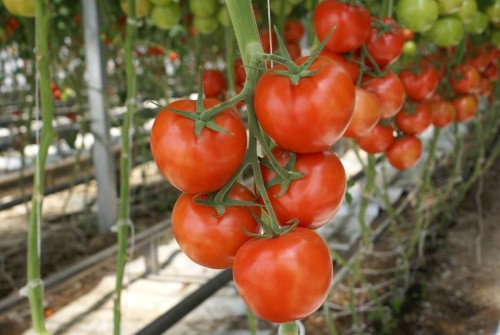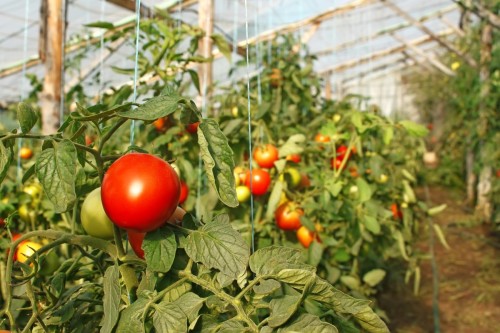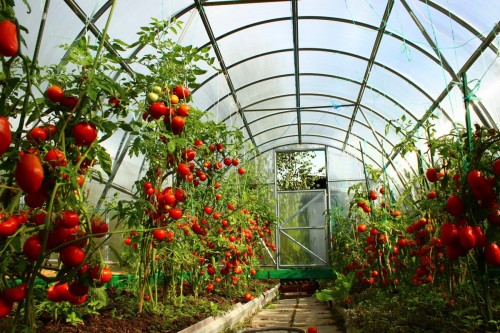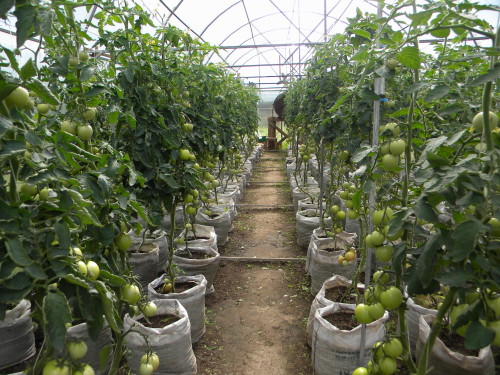The cultivation of tomatoes is the process that almost all the avid gardeners adore. Each of them wants to get a really big harvest, and for this they apply a lot of effort. Unfortunately, not always everything is successful, but certain recommendations allow you to enjoy a really large harvest.
Of course, if we are talking about tomatoes, it is advisable to grow it in the greenhouses. If you choose the optimal conditions, then this space will become for red fruits - an ideal place. Accordingly, it is extremely simple to obtain a shared harvest with this scenario.
However, it is necessary to understand that before using the greenhouse, tomatoes pass a sufficiently long way from sulking and before dive.
It becomes clear that this question is really voluminous, so it is necessary to analyze the specifics of growing tomatoes deep enough.
In this article, we will consider the main features related to the cultivation of tomatoes in a greenhouse from polycarbonate. Avoid gardeners and gardeners note that in order to obtain a truly excellent harvest within the greenhouse, experience is required. In their opinion, this is the most important thing that a person may have if such tasks are facing it. With the help of our material, you can get a little closer to the positive result of the cultivation of tomatoes, and with the help of the experience gained to further multiply success.
Preliminary events
At the very beginning, if we are talking about the cultivation of tomatoes, it will be necessary to prepare the sowing material. Most often, seeds that are on sale, dued, and they are not needed to be handled. In other cases, seeds must be placed in phytosporin-m solution. This solution is in a free sale, and with the help of the attached instructions, you can easily spend the whole process.
After that, the seeds can be filled again into the liquid, but already in the one that is necessary to accelerate growth.
Experts note that at the initial stages of this process it is necessary to prepare the soil for sowing. It is also known that since February to March, seeds can be seeded. Much depends on the variety of tomatoes. For example, late varieties should be imprisoned in about February, and early - at the very end of March.
Hay to seedlings
For this process, we will need small boxes whose height will be approximately 6 cm. It is extremely important to pay attention to the soil mixture, on the basis of which the growth of tomatoes will begin. Specialists advise the choice in favor of a mixture of peat, humus and land in a ratio of 1: 1: 1. All this must be moistened, as well as add a liter river sand, a tablespoon of wood ash, as well as another tablespoon of superphosphate.
By the way, on sale you can find ready-made mixtures for cultivation, so for those who doubt the qualitative result of their own attempts, one should look at such products.
Thus, in the boxes that were prepared in advance, soil is poured, and also compacted. After that, it is necessary to create small grooves in a depth of 1.5 cm. Now you need to pour them with a solution of sodium humate, with warm, well, and after that, seeds occur. The earth is covered on top of the seeds, and the box itself needs to be placed in a bright place, the temperature in which will be at least +22 degrees Celsius.
Experienced gardeners note that to accelerate the seedlings of the seedlings, it is necessary to cover the films with film caps. It often often allows you to significantly accelerate the growth of tomatoes.
Dive
The dive process is a plant transplant from a smaller capacity to the greater. It is necessary for the culture to develop faster.
Accordingly, if we are talking about tomatoes, then it should be noted here when 2 sheets appear in the plant. This happens about a week after the first shoots appear.
Funny, but to transplant plants from the box to another container requires a conventional toothpick. It is worth understanding that this process is responsible, so caution here is clearly not excess. In the end, small coma from the ground should be obtained, which is advisable to move to pots.
In the seedling tanks should be traded about 50 days. If the conditions in which plants are located are optimal, then by this time their height will be approximately 30 cm. It is extremely important to monitor the temperature inside the space. As we have already spoken, plants are most developed at a temperature of +22 degrees. In addition, light conditions are important, so the gardeners are almost every day turn the plant to a particular side to the window so that development takes place as evenly as possible.
The responsible stage on the way to the transplantation of plants to the greenhouse is their hardening. Obviously, the conditions that are in the greenhouse are far from the most severe, but some temperature differences can significantly affect the seedlings. Therefore, 10 days before the disembarkation, it is necessary to carry plants on the balcony, as well as leave them in the room with open vents.
Experts note that in such situations - the main thing is not to overdo it, since too sharp temperature differences can simply destroy vegetation.
Preparing greenhouse to seedlings
Even if at the very beginning, tomatoes were pleased with active growth, after transplantation to the greenhouse plants can even stop developing at all. This suggests that the preparation of greenhouses to transplant vegetation is an extremely important stage.
It must be remembered that the planting of tomatoes within the greenhouse occurs around the end of May. At this time, the night are still cold, so the design should be covered with a double layer of film. In addition, you should not forget about the vents that you want to open regularly and create excellent ventilation. Between two layers of film stretched around the greenhouse, a small air layer should be provided. At first glance, this solution does not make any sense, but in fact, such events make it possible to significantly increase the temperature in the greenhouse, and also significantly extends the life of the inner film, which is in optimal conditions and does not lose its original properties.
In addition, if the greenhouse was used last season, you should get rid of a small soil layer (about 10 cm). After that, it is necessary to carry out soil treatment with the help of copper sulfate.
It is extremely important to remember that the cultivation of tomatoes in one greenhouse 2 years in a row is almost true to destroy the new harvest, since since last season there are numerous diseases in the soil, which will easily form fresh plants. It is obvious that the landing of tomatoes in the greenhouse is advisable to produce every two years.
Even before the transplantation of plants, it is necessary to prepare a garden. To do this, it is necessary to break the soil, as well as remove various weeds and make a slightly humus. It is often that the soil, on the basis of which landing occurs, is poor, therefore it makes sense to use some charcoal, as well as large volumes of humus.
Spacelock sites
Before making landing seedlings, you need to pay attention to numerous recommendations:
- First of all, it should be understood that the soil on which the seedlings will be carried out should be enough. If the soil is cold, then the roots will not develop, and, accordingly, after a short period of time, the plant will die. In order to ensure the optimal temperature of the soil, and this is somewhere about +15 degrees Celsius, it is necessary to cover the entire area of \u200b\u200bthe soil with a polyethylene film. In the event that there is no film at hand, you can simply heat the water and pour it the right area. In some cases, this is an even more effective solution than covering the film.
- In addition, there are important restrictions on planting seedlings. The thing is that if planting the plant is too deep, then the growth can be stopped at all. After a deep fit, the stem can give new roots, which will create problems.
- Separately, it is necessary to note the question of fertilizer. Often the situation is in such a way that inexperienced people engaged in the cultivation of tomatoes in the greenhouse use too much fertilizer. It may be manure, urea, chicken litter. Sometimes after this, the vegetable may not be harvested at all, and in its place it is formed thick tops.
- First of all, when transplanting plants, you need to pay attention to the leaves that have a yellowish color. They need to be removed, just like other sick leaves capable of substantial harm to the plant. If you do not respond at all, you can not exclude not the best harvest. In addition, the leaves should not be at the ground level, and they need to be deleted.
- As for the Tomato Transplant Time, it is best to do this in the evening. Accordingly, right before planting, created in the soil of the wells you need to moisten a little.
Plant location
Beginner gardeners often concerns the question associated with the landing scheme of tomatoes. Most often we are talking about the beds that go along the greenhouse, and their width is up to 90 cm. Obviously, the number of these beds depends only on what area has a greenhouse.
It will also be necessary to pass, which is simply necessary for the movement of people. For the passage, there is a rather width of a 60 cm.
Separately, it makes sense to note the tall varieties of tomatoes. It is advisable to grow in a chess order, and the distance between the beds should be 70-80 cm. Directly between the plants you need to take a step of 70 cm.
It often happens that the seedlings that need to be moved to the greenhouse has already rearranged significantly. However, this is not a problem. In the soil you need to make the wells for 12 cm deep, and inside - one more, the depth of which will be equal to the height of the pot. It is necessary to land a pot with seedlings in a deeper well, then pour out the earth. After about 14 days, during which the plant demonstrates an otnaya growth, you can float the second hole. Experts note that this method of planting is truly effective. Most often, the owners make a decision immediately plant deep, and it is often difficult to have difficulties that are not when landing the above way.
Separately, I would like to note the situations in which the gardeners produce landing of tomatoes of different varieties. In this situation, it should be borne in mind that it will affect the crop to be far from the best way. The bottom line is that some varieties may be in cramped conditions that will negatively affect the development of the plant. Thus, it is better to plant just one variety to land, so that you can count on an otnaya harvest.
Tomato Care in Teplice
The issue of care, as specialists noted, is one of the most important, if it comes to growing tomatoes in the greenhouse. Practice shows that tomatoes are more than welcoming to the conditions in which they are.
- The specificity of watering plants. Gardeners with experience know that watering the tomatoes immediately after planting in the greenhouse - should not. It is necessary to wait about 10 days before carrying out such events. If you watering before time, then it is possible that tomatoes do not fit. As for water, which is better to water tomatoes, its temperature should be at least 20 degrees Celsius. At the same time it is impossible to use hot water. Until the moment when the tomatoes do not bloom, it is necessary to make watering every 4 days. As for the volume of irrigation, then approximately 5 liters of water should be obtained by 1 square meter of the square. During the flowering period, the volume of water used sharply increases. Specialists recommend not to fine and use 14 liters of water for each square meter of the square. There is a recommendation at which it is advisable to produce plants in the morning and under the root. When watering, condensate is formed in the evening, and then water drops fall directly on tomatoes.
- Carrying the greenhouse. As is known, the greenhouse is the most space that should be an ideal place for growing various plants. It is also worth noting that the drafts for tomatoes do not constitute any problems, so the ventilation should be carried out regularly. As we have already spoken, the greenhouse should have different vents and other components that will allow to organize high-quality air exchange within this space. In some cases, if the greenhouse is based on the film material, it is necessary to reduce this material below, which will make it possible to create a good exchange of air on the surface. Experienced gardeners are recommended to produce greenhouses about 2 hours after an abundant harvest watering. It is especially important to make these events during flowering. As for the temperature regime directly, with cloudy weather inside the greenhouse, the temperature should be within 18-20 degrees, in a sun period it should not exceed 26 degrees, and at night it cannot be allowed so that the temperature falls below 16 degrees.
- Features feeding. The question associated with the feeding of tomatoes in the greenhouse is often vital. Approximately 2 weeks after placing tomatoes in the greenhouse, you can make the first feeding. To create it, you need to have 10 liters of water, 1 tablespoon of nitroposki, as well as about 0.5 liters of liquid cow. The prepared mixture should be poured into each plant (about 1 l per each). As for the next feeding, here, apart from 10 liters of water, it will take 1 tablespoon of fertilizer under the name "fertility", as well as 1 teaspoon of sulfate. Gardeners note that within one season requires about 4-5 feeding. Of course, you can do without them, but there is no guarantee that the crop will be volumetric. It is important to remember also that in some cases it is possible to move away from the presented recommendations to obtain an even more optimal result of the cultivation of tomatoes, and first of all it applies precisely to plant feeding.
- Tomato garter. About 4 days after the planting of tomatoes, you need to produce garter. This is necessary in order for high plants to be damaged by weight of its own weight. The main thing you need to know about the tomato garter is caution, since it is often the material used for this case may injure the stem. You can find quite a lot of items necessary to trigger tomatoes. Bad news is that a lot of time is spent on all this event, but you need to understand that it is simply necessary to produce a garter.
- Checking. Many know that the bushes of the tomato have steps, which are the side shoots of this plant. It should be noted that over time, the stees will grow and vegetation are significantly shaded. Thus, there is a need to catch meat. This is an extremely simple process, but all this is done carefully and carefully.
Diseases and pests of tomatoes
Surely many have heard of various diseases and pests faced with vegetables. In the case of tomatoes, it is also possible to note numerous problems that significantly affect the production of high-quality crop.
Next, we consider common pests and diseases that are able to adversely affect Tomatoes:
- Anthracnose. This disease is really dangerous and common. With damage, the root of the tomato gradually gets, and the plant itself is rapid. Unfortunately, this ailment also regularly affects cucumbers, so the most favorite vegetables are threatened. This disease can leave their traces in the ground, so before planting tomatoes in the new season, it is necessary to remove the layer of old soil. We talked about it even at the beginning of the material.
- Mosaic. This is a viral disease that regularly affects the late varieties of tomatoes. Sign up this disease is possible by dimming, which can begin to actively spread on the plant. In addition, the leaves begin to change their shape, as well as twist and wrinkle. If this ailment has already begun its "dirty" case, it is impossible to exclude the defeat of most of the crop. For prevention, it is possible to process plants with milk for about once every 10 days.
- Puttune tick. This is a fairly well-known plant disease. It is possible to detect pests on tomatoes, therefore, if possible, you need to quickly remove them so that the plants do not begin to fade. Often, special pills are made in the soil, which exclude the possibility of spreading different pests.
It is worth noting that often tomatoes simply crack up, finally not mature. This is truly often, however, this is not the result of the action of diseases or pests, this is a physiological feature of the plant. Sometimes the cracking of fruits occurs due to the sharply high humidity of the soil.



















 Start a discussion ...
Start a discussion ...